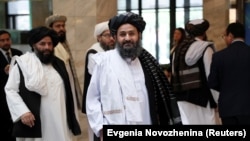Days after the two sides indicated reaching an agreement “in principle,” the cancellation of talks between Afghanistan’s Taliban movement and the United States encapsulates the complexity of peace-making in Afghanistan.
At the heart of this conundrum is the question of whether it is possible to conclude a meaningful agreement with the hard-line Islamist movement that can deliver peace or at least provide a viable path to ending four decades of war in Afghanistan.
“How many more decades are they [the Taliban] willing to fight?” U.S. President Donald Trump asked on September 8 as he announced calling off “peace negotiations” with the Taliban over a September 5 attack in Kabul that killed 12 people, including an American soldier. “If they cannot agree to a cease-fire during these very important peace talks … then they probably don’t have the power to negotiate a meaningful agreement anyway.”
The Taliban swiftly responded by questioning the logic of the suspension. They argued that Trump’s move “will harm America more than anyone else” because “it will damage its reputation, unmask its anti-peace policy to the world even more, increase its loss of life and treasure, and present its political interactions as erratic.”
But the impassioned statements didn’t address the key issue of how exactly to make peace with an Islamist group that has only relied on violence to seize power and mold society and politics to its liking.
Finding a viable answer requires a thorough look at the Taliban’s quarter-century tumultuous history, their core political beliefs, and their ultimate strategy.
The Taliban call themselves the Islamic Emirate of Afghanistan to highlight their core aspiration of recreating the hard-line Islamist regime they built after years of military combat following their emergence in the southern Afghan province of Kandahar in late 1994.
During the 1990s, the Taliban fought against most Afghan military and political factions and prided themselves in defeating them irrespective of ideology or ethnic affiliation. The fact that most of these were mujahedin factions -- Islamist guerrillas who had fought against the Soviet occupation in the 1980s -- indicated that the Taliban opposed their religious and temporal credentials.
While individuals and networks of militants did join the Taliban, the movement rarely tolerated defections or dissent within its ranks. Thus, for most fighters and leaders, joining the group meant no escaping the fold.
This draconian discipline within its ranks has proved a key to the movement’s continuity as an alternate political system designed around the Taliban’s interpretation and practice of Islam. To Taliban leaders and their followers, this is their Islamic Emirate.
During the recent prolonged negotiations with U.S. peace envoy Zalmay Khalilzad, the Taliban insisted on being called the Islamic Emirate, and their leaders said that restoring the Emirate remained a top goal.
“What others call us is not important for us, but we call ourselves Islamic Emirate,” one senior Taliban leader told Radio Free Afghanistan. He requested anonymity because he was formally not authorized to discuss political questions with journalists.
In their formal media statements, the Taliban have attempted to showcase themselves as champions of peace.
“The Islamic Emirate has a solid and unwavering policy,” the September 8 statement by the group claimed. “We called for dialogue 20 years earlier and maintain the same stance today and believe America shall return to this position also.”
The reality is more complex. The Taliban did talk to the administrations of U.S. presidents Bill Clinton and George W. Bush before the 9/11 attacks in 2001. But all contacts with the Taliban ultimately failed because the group refused to extradite Al-Qaeda leader Osama Bin Laden.
After its military intervention in Afghanistan in late 2001, the United States did not accept a Taliban offer to lay down arms in return for amnesty and guarantees that the movement’s leaders could live in dignity. Local rivalries and harassment by Afghan and international troops ultimately prompted the Taliban leaders to move into neighboring Pakistan, from where they launched their insurgency, which still continues.
“Our previous 18-year resistance should have proven to America that we will accept nothing less than the complete end of occupation and allowing Afghans to decide their own fate,” the Taliban statement said. “And we shall continue our jihad for this great cause and maintain our strong belief in ultimate victory.”
Violence remains the key tactic for the Taliban to capture power.
Despite agreeing to take part in an intra-Afghan dialogue, Taliban literature is rife with references that alludes to the group’s belief that its negotiations with Washington are nothing more than a withdrawal agreement, which will pave way for their return to power.
“The Islamic Emirate is proud to be leading the jihad and resistance against the U.S. imperialism,” an insurgent statement making the centenary of Afghanistan’s independence said on August 19. “The ongoing jihad will make sure that the current occupier completely withdraws just like the Soviet and British invaders [during the previous centuries] so that Afghanistan can return to full independence.”
Apart from a brief cease-fire in 2018, the Taliban have rejected most peace overtures by successive Afghan administrations since 2004 and insisted on calling the government in Kabul “puppets.”
The suspension of U.S. talks with the Taliban now has pushed any realistic chances of concluding what U.S. peace envoy Zalmay Khalilzad calls a “comprehensive peace agreement, not a withdrawal agreement” further into the future.







